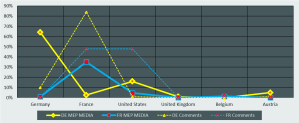While it’s trendy for public affairs professionals talk about social media, Twitter and Blogs, it’s naïve to think these are the main channels for engagement when it come to European Parliament Party leadership. Online mainstream news simply dominates in comparison. It sets the tone of the issue, gets the most comments, and is shared ,“Liked” and Voted on the most.
Diving back into market shares and what leader controls each medium. The chart above shows just how dominate Martin Schulz (at the time leader of the S&D at the European Parliament. Schulz has now replaced Jerzey Buzek as it’s President) was in December. MS controlled just about every medium, as well as has the most comments.
Starting from the right we see Mainstream News percentages and how each leader stacks up:
- Martin Schulz (MS) 63%,
- Guy Verhofstadt (GV) 25%
- Joseph Daul (JD) 12%
On the second box from the left “MS ind MS” shows the market share of the medium/channel, in this case mainstream, is being use by the Party Leader. Mainstream news made up 61% of Martin Schulz’s online media. Comparatively GV is at 44% and JD is 35%. In all cases main stream on-line news provides the most media and comments for all leaders. Over the past six months I’ve seen a rise in Twitter, which is by far the most equal platform, and also JD’s 2nd highest individual medium.
We can conclude two things from the prior chart:
- MS is winning the online battle for media and engagement. He owns 94% of comments leaving only 4% to GV, and 3% to JD.
- JD severely under performs given the EPP’s size and amount of money they have.



